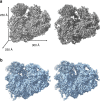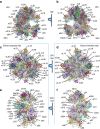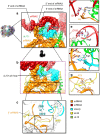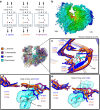Structures and stabilization of kinetoplastid-specific split rRNAs revealed by comparing leishmanial and human ribosomes
- PMID: 27752045
- PMCID: PMC5071889
- DOI: 10.1038/ncomms13223
Structures and stabilization of kinetoplastid-specific split rRNAs revealed by comparing leishmanial and human ribosomes
Abstract
The recent success in ribosome structure determination by cryoEM has opened the door to defining structural differences between ribosomes of pathogenic organisms and humans and to understand ribosome-targeting antibiotics. Here, by direct electron-counting cryoEM, we have determined the structures of the Leishmania donovani and human ribosomes at 2.9 Å and 3.6 Å, respectively. Our structure of the leishmanial ribosome elucidates the organization of the six fragments of its large subunit rRNA (as opposed to a single 28S rRNA in most eukaryotes, including humans) and reveals atomic details of a unique 20 amino acid extension of the uL13 protein that pins down the ends of three of the rRNA fragments. The structure also fashions many large rRNA expansion segments. Direct comparison of our human and leishmanial ribosome structures at the decoding A-site sheds light on how the bacterial ribosome-targeting drug paromomycin selectively inhibits the eukaryotic L. donovani, but not human, ribosome.
Figures







Similar articles
-
Atomic resolution snapshot of Leishmania ribosome inhibition by the aminoglycoside paromomycin.Nat Commun. 2017 Nov 17;8(1):1589. doi: 10.1038/s41467-017-01664-4. Nat Commun. 2017. PMID: 29150609 Free PMC article.
-
A comparison of the yeast and rabbit 80 S ribosome reveals the topology of the nascent chain exit tunnel, inter-subunit bridges and mammalian rRNA expansion segments.J Mol Biol. 2000 Aug 11;301(2):301-21. doi: 10.1006/jmbi.2000.3947. J Mol Biol. 2000. PMID: 10926511
-
High-resolution cryo-electron microscopy structure of the Trypanosoma brucei ribosome.Nature. 2013 Feb 21;494(7437):385-9. doi: 10.1038/nature11872. Epub 2013 Feb 10. Nature. 2013. PMID: 23395961 Free PMC article.
-
The three-dimensional structure of the ribosome and its components.Annu Rev Biophys Biomol Struct. 1998;27:35-58. doi: 10.1146/annurev.biophys.27.1.35. Annu Rev Biophys Biomol Struct. 1998. PMID: 9646861 Review.
-
The conformation of ribosomes and rRNA.Curr Opin Struct Biol. 1997 Jun;7(3):343-7. doi: 10.1016/s0959-440x(97)80049-8. Curr Opin Struct Biol. 1997. PMID: 9204275 Review.
Cited by
-
Interaction Networks of Ribosomal Expansion Segments in Kinetoplastids.Subcell Biochem. 2021;96:433-450. doi: 10.1007/978-3-030-58971-4_13. Subcell Biochem. 2021. PMID: 33252739 Review.
-
Structural Heterogeneities of the Ribosome: New Frontiers and Opportunities for Cryo-EM.Molecules. 2020 Sep 17;25(18):4262. doi: 10.3390/molecules25184262. Molecules. 2020. PMID: 32957592 Free PMC article. Review.
-
Ribosome Stoichiometry: From Form to Function.Trends Biochem Sci. 2019 Feb;44(2):95-109. doi: 10.1016/j.tibs.2018.10.009. Epub 2018 Nov 22. Trends Biochem Sci. 2019. PMID: 30473427 Free PMC article. Review.
-
The mechanism of translation.F1000Res. 2017 Mar 1;6:198. doi: 10.12688/f1000research.9760.1. eCollection 2017. F1000Res. 2017. PMID: 28344776 Free PMC article. Review.
-
Nonstandard RNA/RNA interactions likely enhance folding and stability of segmented ribosomes.RNA. 2022 Mar;28(3):340-352. doi: 10.1261/rna.079006.121. Epub 2021 Dec 7. RNA. 2022. PMID: 34876487 Free PMC article.
References
-
- World Health Organization. Control of the leishmaniases. World Health Organization Tech Rep Ser 949, 67–71 (2010). - PubMed
-
- Anger A. M. et al.. Structures of the human and Drosophila 80S ribosome. Nature 497, 80–85 (2013). - PubMed
-
- Khatter H., Myasnikov A. G., Natchiar S. K. & Klaholz B. P. Structure of the human 80S ribosome. Nature 520, 640–645 (2015). - PubMed
Publication types
MeSH terms
Substances
Grants and funding
LinkOut - more resources
Full Text Sources
Other Literature Sources

